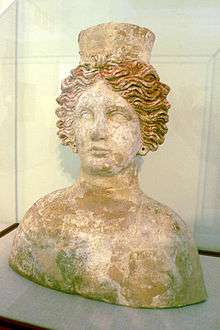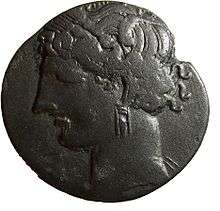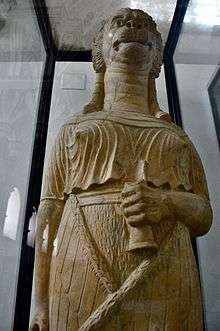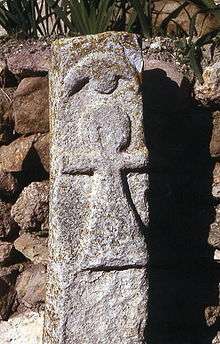Tanit
Tanit[1] was a Punic and Phoenician goddess, the chief deity of Carthage alongside her consort Baal-Hamon.[2][3] She was also adopted by the Berber people.

Tanit is also called Tinnit. The name appears to have originated in Carthage (modern day Tunisia), though it does not appear in local theophorous names.[4] She was equivalent to the war goddess Astarte, and later worshipped in Roman Carthage in her Romanized form as Dea Caelestis, Juno Caelestis, or simply Caelestis.
In modern-day Tunisian Arabic, it is customary to invoke Omek Tannou or Oumouk Tangou ('Mother Tannou' or 'Mother Tangou', depending on the region), in years of drought to bring rain.[5] Similarly, Tunisian and many other spoken forms of Arabic refer to "Baali farming" to refer to non-irrigated agriculture.[6]
Worship

Tanit was worshiped in Punic contexts in the Western Mediterranean, from Malta to Gades into Hellenistic times. From the fifth century BCE onwards, Tanit's worship is associated with that of Baal Hammon. She is given the epithet pene baal ('face of Baal') and the title rabat, the female form of rab ('chief').[7] In North Africa, where the inscriptions and material remains are more plentiful, she was, as well as a consort of Baal-hamon, a heavenly goddess of war, a "virginal" (unmarried) mother goddess and nurse, and, less specifically, a symbol of fertility, as are most female forms.[8] Several of the major Greek goddesses were identified with Tanit by the syncretic interpretatio graeca, which recognized as Greek deities in foreign guise the gods of most of the surrounding non-Hellene cultures.

Her shrine excavated at Sarepta in southern Phoenicia (modern-day Lebanon) revealed an inscription that has been speculated, but as of yet not proven, to identify her for the first time in her homeland and related her securely to the Phoenician goddess Astarte (Ishtar).[9] One site where Tanit is uncovered is at Kerkouane, in the Cap Bon peninsula in Tunisia
Child sacrifice
The origins of Tanit are to be found in the pantheon of Ugarit, especially in the Ugaritic goddess Anat (Hvidberg-Hansen 1982). There is significant, albeit disputed, evidence, both archaeological and within ancient written sources, pointing towards child sacrifice forming part of the worship of Tanit and Baal Hammon.[10]
Some archaeologists theorised that infant sacrifices have occurred. Lawrence E. Stager, who directed the excavations of the Carthage Tophet in the 1970s, believes that infant sacrifice was practiced there. Paolo Xella of the National Research Council in Rome summarized the textual, epigraphical, and archaeological evidence for Carthaginian infant sacrifice.[11]
Archaeological evidence
Tophet is a Hebrew term from the Bible, used to refer to a site near Jerusalem at which Canaanites and Israelites who strayed from Judaism by practicing Canaanite idolatry were said to sacrifice children. It is now used as a general term for all such sites with cremated human and animal remains. The Hebrew Bible does not specify that the Israelite victims were buried, only burned, although the "place of burning" was probably adjacent to the place of burial. We have no idea how the Phoenicians themselves referred to the places of burning or burial, or to the practice itself.
Several apparent tophets have been identified, chiefly a large one in Carthage, dubbed the Tophet of Salammbó, after the neighbourhood where it was unearthed in 1921.[12] Soil in the Tophet of Salammbó was found to be full of olive wood charcoal, probably from the sacrificial pyres. It was the location of the temple of the goddess Tanit and the necropolis. Animal remains, mostly sheep and goats, found inside some of the Tophet urns, strongly suggest that this was not a burial ground for children who died prematurely. The animals were sacrificed to the gods, presumably in place of children (one surviving inscription refers to the animal as "a substitute"). It is conjectured that the children unlucky enough not to have substitutes were also sacrificed and then buried in the Tophet. The remains include the bodies of both very young children and small animals, and those who argue in favor of child sacrifice have argued that if the animals were sacrificed then so too were the children.[13] The area covered by the Tophet in Carthage was probably over an acre and a half by the fourth century BCE,[14] with nine different levels of burials. About 20,000 urns were deposited between 400 BCE and 200 BCE,[14] with the practice continuing until the early years of the Christian period. The urns contained the charred bones of newborns and in some cases the bones of fetuses and two-year-olds. These double remains have been interpreted to mean that in the cases of stillborn babies, the parents would sacrifice their youngest child.[15]
A detailed breakdown of the age of the buried children includes pre-natal individuals – that is, still births. It is also argued that the age distribution of remains at this site is consistent with the burial of children who died of natural causes, shortly before or after birth.[13] Sergio Ribichini has argued that the Tophet was "a child necropolis designed to receive the remains of infants who had died prematurely of sickness or other natural causes, and who for this reason were "offered" to specific deities and buried in a place different from the one reserved for the ordinary dead". He adds that this was probably part of "an effort to ensure the benevolent protection of the same deities for the survivors."[16] However, this analysis is disputed; Patricia Smith and colleagues from the Hebrew University and Harvard University show from the teeth and skeletal analysis at the Carthage Tophet that infant ages at death (about two months) do not correlate with the expected ages of natural mortality (perinatal).[17]
Other usage

Long after the fall of Carthage, Tanit was still venerated in North Africa under the Latin name of: Juno Caelestis, for her identification with the Roman goddess Juno.[18] The ancient Berber people of North Africa also adopted the Punic cult of Tanit.[19] Her symbol (the sign of Tanit), found on many ancient stone carvings, appears as a trapezium closed by a horizontal line at the top and surmounted in the middle by a circle; the horizontal arm is often terminated either by two short upright lines at right angles to it or by hooks. Later, the trapezium was frequently replaced by an isosceles triangle. The symbol is interpreted by Danish professor of Semitic philology F. O. Hvidberg-Hansen as a woman raising her hands. Hvidberg-Hansen notes that Tanit is sometimes depicted with a lion's head, showing her warrior quality.[20]
In modern times the name, often with the spelling Tanith, has been used as a female given name, both for real people (such as the writer Tanith Lee and model Tanit Phoenix) and in fiction.
Cultural references
In Gustave Flaubert's historical novel Salammbô (1862), the title character is a priestess of Tanit. Mâtho, the chief male protagonist, a Libyan mercenary rebel at war with Carthage, breaks into the goddess's temple and steals her veil.[21]
In Kate Elliott's Spiritwalker trilogy, a romanticised version of Tanit is one of many deities commonly worshiped in a polytheistic Europa. The narrator, Catherine, frequently appeals to "Blessed Tanit, Protector of Women", and the goddess occasionally appears to her.
G. K. Chesterton refers to Tanit in his account of the Punic Wars, "War of the Gods and Demons" (a chapter of his book The Everlasting Man). Describing the cultural shock of foreign armies invading Italy when Hannibal crossed the Alps, Chesterton wrote:
It was Moloch upon the mountain of the Latins, looking with his appalling face across the plain; it was Baal who trampled the vineyards with his feet of stone; it was the voice of Tanit the invisible, behind her trailing veils, whispering of the love that is more horrible than hate.
In Margaret Atwood's The Blind Assassin there is an epigraph on a Carthaginian funerary urn that reads: "I swam, the sea was boundless, I saw no shore. / Tanit was merciless, my prayers were answered. / O you who drown in love, remember me."
In John Maddox Roberts's alternate history novel Hannibal's Children, in which the Carthaginians won the Second Punic War, one of the characters is Princess Zarabel, leader of the cult of Tanit.
Isaac Asimov's 1956 science fiction short story "The Dead Past" tells of Arnold Potterley, a professor of ancient history, who is obsessed with exonerating the Carthaginians of child sacrifice and tries to gain access to the chronoscope, a device which allows direct observation of past events. Eventually, Potterley's obsession with the Carthaginian past has far-reaching effects on the society of the present.
See also
Notes
- 'TNT in Phoenician and Punic inscriptions.
- Miles, Richard (2011). Carthage Must Be Destroyed: The Rise and Fall of an Ancient Civilization. Penguin. p. 68.
- The standard survey is: Hvidberg-Hansen, F. O. (1982). La déesse TNT: Une Etude sur la réligion canaanéo-punique (in French). Copenhagen: Gad.. An extensive critical review by G. W. Ahlström appeared in Journal of Near Eastern Studies 45(4), October 1986, pp. 311–314.
- Bleeker, Claas Jouco; Widengren, Geo (1988). Historia Religionum, Volume 1: Religions of the Past. Brill. pp. 209 ff. ISBN 90-04-08928-4.
At Carthage the great goddess is called Tinnit (formerly read Tanit).... It would seem that Tinnit is the specific Carthaginian form of Astarte, but strangely enough there are no theophorous names containing the element Tinnit, while there are a few with Astarte. The name seems to have originated in Carthage....
- Rezgui, Sadok (1989). Les chants tunisiens (in French). Tunis: Maison tunisienne de l'édition.
- Ottavo contributo alla storia degli studi classici e del mondo antico Arnaldo Momigliano - 1987 p240.
- Markoe 2000:130.
- "Tanit | ancient deity". Encyclopaedia Britannica (online ed.). Retrieved 8 August 2017.
- Pritchard, James B. (1978). Recovering Sarepta, a Phoenician City. Princeton University Press.. The inscription reads TNT TTRT, and could identify Tanit as an epithet of Astarte at Sarepta, for the TNT element does not appear in theophoric names in Punic contexts (Ahlström 1986 review, p 314).
- Markoe, p. 136
- Xella, Paolo; Quin, Josephine; Melchiorri, Valentina; van Dommelen, Peter. "Phoenician bones of contention". Antiquity. 87 (338): 1199–1207. doi:10.1017/s0003598x00049966. Retrieved 17 February 2014.
- Briand-Ponsart, Claude; Crogiez, Sylvie (2002). L'Afrique du nord antique et médievale: Mémoire, identité et imaginaire (in French). Publications de l'Université de Rouen et du Havre. p. 13. ISBN 2-87775-325-5.
- Schwartz, Jeffrey H.; Houghton, Frank; Macchiarelli, Roberto; Bondioli, Luca (17 February 2010). "Skeletal Remains from Punic Carthage Do Not Support Systematic Sacrifice of Infants". PLOS One. Public Library of Science. 5 (2): e9177. Bibcode:2010PLoSO...5.9177S. doi:10.1371/journal.pone.0009177. PMC 2822869. PMID 20174667. Retrieved 23 January 2014.
- Stager 1980, p. 3.
- Stager 1980, p. 6.
- Ribichini 1988, p. 141.
- Smith, Patricia; Stager, Lawrence E.; Greene, Joseph A.; Avishai, Gal. "Age estimations attest to infant sacrifice at the Carthage Tophet". Antiquity. 87 (338): 1191–1199. doi:10.1017/s0003598x00049954. Retrieved 23 January 2014.
- Tate, Karen (2008). Sacred Places of Goddess. CCC Publishing. p. 137. ISBN 1-888729-11-2.
- Brett, Michael; Fentress, Elizabeth (1997). The Berbers. Blackwell. p. 269.
- Azize, Joseph. The Phoenician Solar Theology. p. 177.
- Porter, Laurence M. (2002). Gustave Flaubert's "Madame Bovary": A Reference Guide. Greenwood. p. xxxi.
References
- Markoe, Glenn E. (2000). Phoenicians. "Peoples of the Past" series. Berkeley: University of California Press. ISBN 9780520226142. OCLC 45096924.
External links
![]()